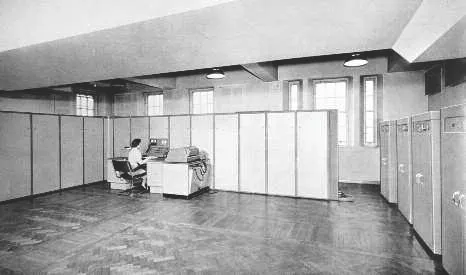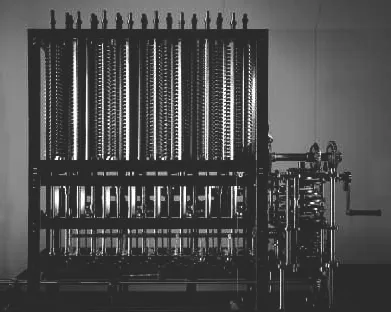![]()
1
Polar Positions
The story of the development of the electronic computer from its initial form as a forbidding room-sized construction, and its transformation into an innocuous box sitting on top of an office desk, is a complex, convoluted one, which could, and indeed has, filled a number of books. But those two polar positions are perhaps the most interesting points at which to concentrate an account of the design history of the computer as a physical object. At one end of the scale is an awe-inspiring, esoteric piece of unfamiliar and potentially threatening new technology of huge magnitude, understood by few and feared by many. At the other end of the scale is a familiar, unobtrusive piece of everyday office equipment, understood by all and feared by none. A single operator sat alone at a control desk amid a large room of anonymous steel cabinets is a recurring image in early computing, contrasting powerfully with later images of users working alongside a smaller number of more human-scale units. The miniaturization of electronic components reduced the size of the computer beyond the imagination of early pioneers to a position where a stand-alone computer could be built into an office desk, and eventually placed within a single case which could sit on the desktop. The physicality of the computer has played a key role in defining the experience of operating the machine. We have moved from working within the confines of the computer to working on computers wholly within the operator’s grasp, and along the way our relationship to a fundamentally similar piece of technology has changed completely.
Ferranti Mercury, 1960. Operators of early computers often looked lost within huge rooms of equipment.
The vast majority of computers produced today are anonymous pieces of work. The result of research and development teamwork between engineers, programmers and designers, they are very rarely associated with particular individuals. This is, perhaps, not surprising given that the computer is now a quotidian commodity item, just one more product among the plethora of consumer goods we encounter every day. Earlier attempts to produce electronic computers, though, were much more bound up with the struggle to make significant breakthroughs; to realize theoretical aspirations; to shape the future of technological development. The pioneers attempting to do this were people driven – be it by personal ambition, intellectual curiosity or national pride – into chasing a dream, of being the first to succeed where others had failed.
As a consequence of such fervour, early developments in computing are more often than not couched in the rhetoric of scientific discovery and heroic achievement. The enormous effort and resources required were channelled into a relatively small number of ground-breaking projects to create singular machines, and the narratives surrounding their creation are therefore closely associated with the particular individuals, teams and institutions pushing particular boundaries, and are understandably focused far more on the circumstances of their production rather than their consumption (which at that point was in any case limited).
Although it is the intention in this book to focus on the development of the modern electronic computer rather than to go back to the abacus and work forward (as many others have done) it would be inappropriate not to at least mention here the achievement and influence of Charles Babbage. In 1821 Babbage, a mathematician, and John Herschel, an astronomer, were consulting the manually calculated mathematical tables used at the time for all kinds of astronomical, engineering and navigational purposes, and found them to contain a significant number of inaccuracies. These errors were not only inconvenient, they were also fatal (one set of navigational tables was found to contain over 1,000 miscalculations and was believed to have caused many shipwrecks). Babbage concluded that if these tables could be generated by a reliable calculating machine, lives would be saved. Babbage was extremely well connected and highly respected in Victorian social circles, and he used this influence and a working demonstration model to secure large amounts of money from the government to develop such a calculating machine. His highly ambitious design for the ‘Difference Engine’, as he named it, called for an incredible 25,000 precision-engineered parts to be accurately assembled. After ten years of development work and constant reassurances that he was near completion, Babbage changed the design and started again. Infuriated, the government finally withdrew its support. The Difference Engine No. 2 was never completed in his lifetime and many critics believed that the design was beyond the limits of the manufacturing technology of the day. That notion was finally put to rest in 1991, when the Science Museum in London completed the construction of a machine to Babbage’s plans using production tolerances achievable during his lifetime. It worked perfectly.
Babbage’s reluctance to settle on a finalized design also meant that his plans for an even more ambitious, punched-card programmable machine1 called the Analytical Engine were never realized, although it is now widely recognized that its design, consisting of stored memory and processing units, closely resembled that of a modern-day electronic computer. Consequently, Babbage is the earliest of the many contenders proposed for the title of ‘the father of computing’, setting a precedent in the history of computing for celebrating the conceptualization of a process as being of equal to or of more importance than its realization.2
Although they were largely the creation of a single individual, that Babbage’s computers were products of the establishment is beyond question. As if it were created in direct response to the burgeoning industrial revolution, the Difference Engine was a physical manifestation of the division of labour,3 and because of his approach to the processing of information and logical efficiency, Babbage ‘embodied a link between calculating machinery and rational industrial management that has never since been broken’.4
Mechanical calculating machinery continued to be developed over the next century, resulting in a wide variety of machines that fall outside the scope of this book and are far too numerous to list comprehensively here. The adoption of mechanical relays used in telephone systems led to important developments in analogue electromechanical computing, such as the German Konrad Zuse Z3 Computer of 1941 and electronic circuits were first used in the American, nonprogrammable Atanasoff-Berry Computer (ABC) of 1939. Both of these had an impact on later, programmable electronic computers, but that impact was not perhaps as significant as earlier work by Herman Hollerith. His doctoral thesis led to the design of the Hollerith Mechanical Tabulator, which sorted data stored on punched cards. The machine was used by the US Census Office in 1890 and cut the time taken to collate all the census information from eight years to just one year. Hollerith’s Tabulating Machine Company later became International Business Machines, better known as IBM – for many years the most important computer manufacturer in the world. IBM did more than any other institution in bringing the electronic computer to the world of business, but they did not invent it. As with so many other important inventions, the programmable electronic computer emerged from the pressures of war. Two different military requirements were highly influential in driving the development of computing forward during the Second World War. The first, with activity centred in the UK, was the need to decipher the enemy’s coded messages for military intelligence purposes, and the second, with activity centred in the USA, was to speed up the calculation of ballistics information and produce firing tables with the same kind of accuracy Babbage had intended.
Reconstruction of Difference Engine No. 2. The Science Museum’s reconstruction of Babbage’s Difference Engine proved that had it ever been built, it would have worked perfectly.
The Military Machine
What they did with Colossus, the first day they got it, was to put a problem onto it which they knew the answer. It took about half an hour to do the run. They let it run for about four hours, repeating the processes every half hour, and to their amazement, it gave the same answer every time. They were really amazed. It was that reliable, extremely reliable.5
The activities of code-breakers in the Second World War have been described in a number of factual accounts, but were widely popularized by Robert Harris in his 1995 novel Enigma, later made into a British movie. Enigma glamorized life around the grounds of the Buckinghamshire mansion that formed the base of secret cryptographic endeavour, and focused largely on the love interest between Tom Jericho, a brilliant young mathematician, and Hester Wallace, a worker at the base and a housemate of Jericho’s former lover Claire, who has mysteriously disappeared. Their search for Claire uncovers a government plot to keep America in the war, and leads to the uncovering of a Polish spy they follow to Scotland, where the U-boat he is boarding is bombed.
A visit to the former site of the Government Code and Cypher School at Bletchley Park today, however, paints a less romantic picture. A tour around the decaying remains of the cold, cramped and damp huts in which the logging and decoding of intercepted messages took place gives one an appreciation of the dedication of the many hardworking staff in very difficult conditions, and makes their achievements appear all the more remarkable. Personal accounts of working there describe the bare concrete floors, light bulbs without shades, wooden trestle tables and broken electric stoves. ‘It was dreadful . . . We all froze. We had to wear coats and mittens.’6 Today, those bleak rooms form a fascinating museum displaying the equipment they used and describing their work in detail. The museum also has working examples of the many machines developed to make and break codes during the war, including a reconstruction of the first ever totally electronic computer. Because it formed part of such an important war operation, the story of its creation was for many years kept totally secret and it is something of a miracle that a reconstruction has been assembled at all.
Following the First World War, the Enigma cipher machine was developed by the German inventors Arthur Scherbius and Richard Ritter to overcome the limitations of previously used handwritten methods of encoding secret messages. The machine used an ingenious rotor system to scramble each letter of a message individually so that even if the same letter were keyed in twice in a row, the coded letters produced would be different. The sequence of the letters generated was dependent on the initial position of the rotors, and the three-rotor system in the Enigma machine had billions of possible initial positions, making the code extremely difficult (but not impossible) to break. Cryptographers at Bletchley Park used ‘cribs’ – inspired guesses at the meanings of small sections of messages – to reduce the possible initial positions from billions to thousands, but these still required laborious checking to find the right answer. In 1940 the celebrated mathematician Alan Turing developed the work of Polish cryptographers to create an electro-mechanical code-breaking machine called a ‘Bombe’, which could check the thousands of possible variations and successfully decode Enigma messages within a few hours. There was, however, a higher-level code generated by a ten-rotor machine called the Lorenz cipher used for top-level strategic communications. Even with the use of ‘cribs’, the number of possible variations of initial settings within the Lorenz cipher was far too great for the mechanical relay-based Bombe machines to tackle. A mistake made by a German operator in sending a long message twice with the same initial settings enabled the logic of the code to be deduced, and armed with this information, Bletchley Park mathematician Max Newman (Turing’s tutor at Cambridge) asked the Telecommunications Research Establishment at Malvern to produce an electronic machine to automate the method of finding initial code settings.
The resulting machine looked so eccentric in its construction that its operators named it ‘Heath Robinson’ after the famous illustrator of complex cartoon mechanisms. It was built at the Post Office Research Station at Dollis Hill, London, and used two paper tapes which ran on spiked wheels at speeds of 1,000 characters per second – one containing potential rotor settings and one containing the coded message. The Robinson machine worked well enough to prove the concept, but the paper tapes were not easily kept synchronized when running at the speeds necessary to decode a message within a reasonable time-frame. The spiked wheels kept ripping the paper. Another considerable problem was that the answer produced by the Robinson machine depended on an unreliable mechanical counter, and often, the answers given for the same message were different.
Because of these problems, Newman proposed an electronic computer to decipher Lorenz messages, but it was deemed unworkable. Because the Robinson machine was made almost completely from telephone switching components, Tommy Flowers, an electrical engineer at Dollis Hill who had impressed Turing during his wor...


